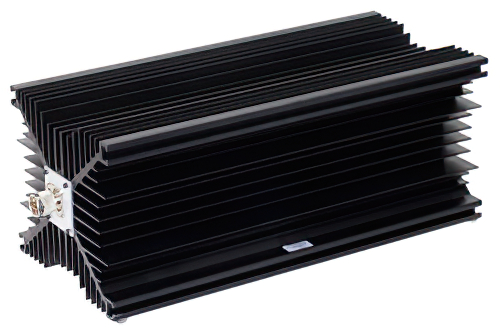 RF Attenuators come in a wide variety of packages, technologies, and performance ranges. Some RF attenuator technology is compact enough to fit on an IC, while some units are large enough to require internal and/or external thermal management systems. The size and significance of the thermal management of an RF attenuator depends on the attenuator technology, amount of attenuation, RF input signal power range, and frequency range.
RF Attenuators come in a wide variety of packages, technologies, and performance ranges. Some RF attenuator technology is compact enough to fit on an IC, while some units are large enough to require internal and/or external thermal management systems. The size and significance of the thermal management of an RF attenuator depends on the attenuator technology, amount of attenuation, RF input signal power range, and frequency range.
The basic use of an attenuator is to absorb a set amount of the energy of an RF signal passing through the attenuator without otherwise disrupting the phase or frequency response of the signal. Attenuators are often used to protect sensitive test and measurement equipment or circuitry from high RF signal levels, but may also be used to extend the range of RF power meters and amplifiers. In some cases attenuators are also used in between reflective components to mitigate the development of standing waves from reflections that would otherwise build between two such components or devices. Also, impedance matched RF attenuators also improve impedance matched between two mismatched nodes in the signal chain.
High Power RF Attenuators differ from other RF attenuators in that they are specifically designed for RF signal ranges considered high power for the given maximum frequency. This is somewhat a dubious definition, as what is considered high power often depends on the application and operating frequency range. At hundreds of kilowatts to megahertz, hundreds to thousands of watts of power may be considered high power, while in the millimeter-wave spectrum around 18 GHz tends of watts may be considered high power. This discrepancy is partially due to the increase in RF losses as a function of frequency, as well as the reduced geometries of transmission lines and other components/devices to perform well at higher frequencies. The smaller sizes and spacing between conductors and dielectrics in higher frequency devices limits the power handling capability of transmission lines, components, and devices at higher frequencies. For instance, coaxial transmission lines at higher frequencies necessarily need to stay below a certain center-conductor to outer conductor spacing and size to prevent the development of non-desired transmission modes that would otherwise present degraded efficient use of the generally desired transverse-electromagnetic (TEM) mode.
Hence, High Power Attenuators are designed to handle power levels near the peak of capability for a given frequency while presenting a fixed attenuation across the entire frequency band. Designing such attenuators is no easy feat, as maintaining a flat attenuation over a wide frequency range, from DC to tens of gigahertz in some cases, involves several challenging design requirements. One of the main requirements of High Power RF Attenuators is to minimize the VSWR of the ports to prevent unintended reflections that could damage components sensitive to oncoming high signal energy.
Other valuable features for these components is their directionality. Some RF attenuators are directional, in that they only behave as specified if the RF signal enters a specific port and exits the other port. Other RF attenuator designs are bi-directional, and can be used when the attenuation of signals from either direction is needed.
As with most RF components, RF attenuators do suffer from derating increased temperature. This is an important feature to consider with a High Power RF Attenuator, as the attenuator will naturally increase in temperature as it absorbs RF energy. If an attenuator reaches its maximum temperature, the drafted attenuation can be substantially lower than the attenuation species at room temperature. If the attenuator derating isn’t kept in mind, signal levels exceeding prescribed limits may pass through the heated attenuator and damage downstream equipment or circuits. This is why High Power RF Attenuators have substantial heat sinks or other thermal management measures to ensure a consistent operating temperature.
Learn more about Pasternack’s High Power RF Attenuator product line.




 Pasternack Blog
Pasternack Blog
